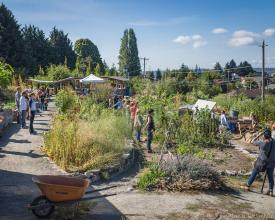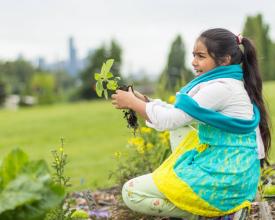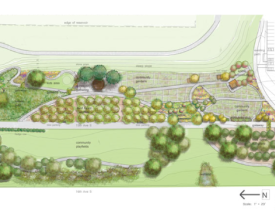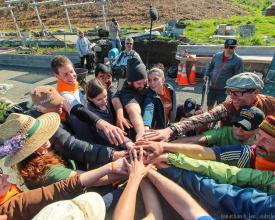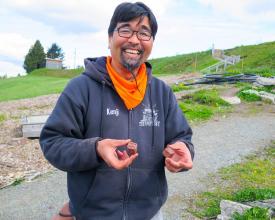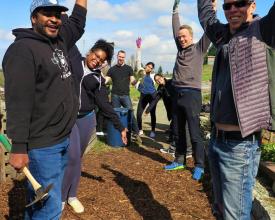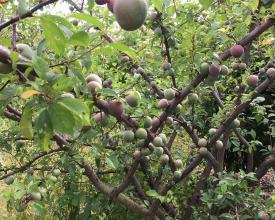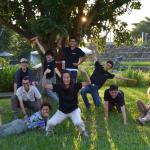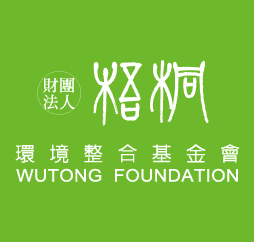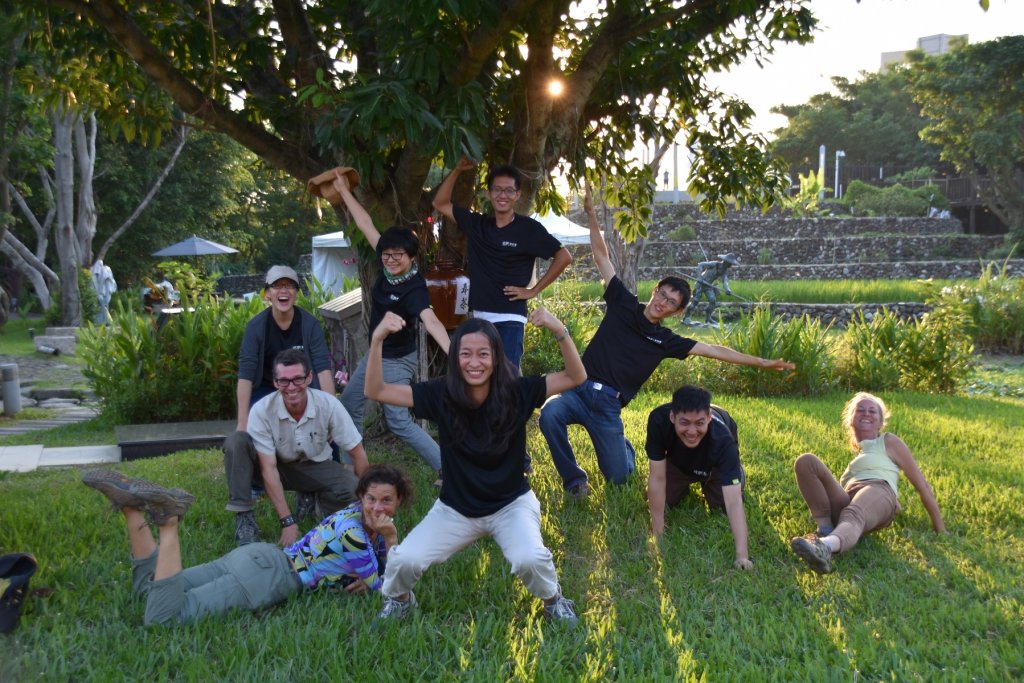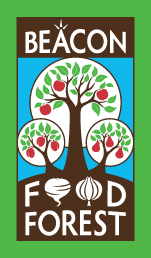
Growing food, community and biodiversity with permaculture - Beacon Food Forest
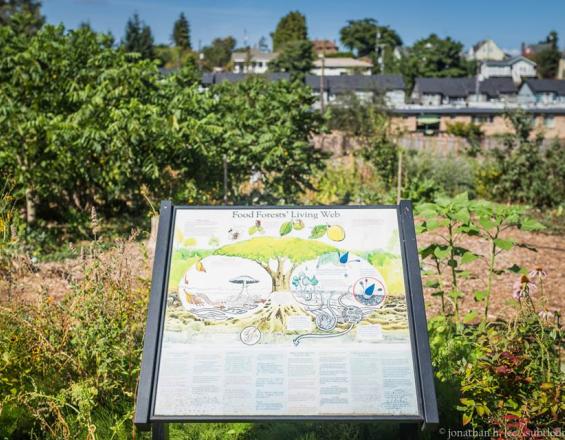
The Beacon Food Forest is a community-powered permaculture project that took off in 2009, aiming to create a sustainable model that can support the community with affordable, healthy food, knowledge on growing food and biodiversity, and a sense of belonging in the face of climate change and food security issues. A food forest is a sustainable model that mimics the ecosystem of a natural forest but substitutes certain species with ones that have the same ecological function and are edible to humans.
The project is located on a leisure public land in Seattle, and it is built and maintained entirely by local residents as volunteers. All harvests are open for picking by any passerby, and work is shared by residents and new-comers as a group. By making the project open to all with a clear code of conduct, the project quickly gathered hundreds of residents from different walks of life, contributing tools, skills, and knowledge that can be gathered and passed down to the younger generation.
Contexte
Challenges addressed
In large cities where most food is imported, food security is an imminent crisis in the face of climate change. The project hopes to transform 7 acres of public land into a productive food forest that can help secure local food source. For that, we must also face the challenge of growing food on a land with depleted soil, water erosion, and invasive species.
Food justice and a sense of loss are two social challenges in large cities. Being public, the Beacon Food Forest advocates free food for all, regardless of backgrounds level of participation. People here garden as a group rather than in individual plots. This helps to diminish the sense of division and encouragement for food justice; it also helps the sense of loss as people find themselves working for a common interest.
Large-scale capitalism has proven itself inefficient in terms of resources used and waste generated. The Beacon Food Forest sets an example of small-scaled, circular economic model by localizing inputs and outputs.
Emplacement
Traiter
Summary of the process
The process of the Beacon Food Forest can be stated via the following stages: 1) bring forth a clear vision, 2) gain the agreement to use the land, 3) design the food forest, 4) build the food forest and volunteers, 5) utilize and maintain the food forest. Resilience was the first building block in the first stage which clearly defined the food forest as an environmentally sustainable model. However, in stage 2 and 3, diversity was the most important building block because it meant that the food forest was of public interest, which is a key to getting lots of support. In addition, incorporating ideas from diverse communities into the design also helped to make the design better fit the needs of these communities, which then increased their chance of participation in the later stage. In stage 4 and 5, community empowerment was the primary building block that helped to build a group of volunteers that can share the work and, more importantly, carry on the work even if the initiators were not there. Whilst resilience defined the food forest as an environmentally sustainable model, diversity and community empowerment defined the food forest as a socially sustainable model.
Building Blocks
Community empowerment
A successful solution requires a strong community where all are given enough knowledge (aka. power) and trust to fully engage themselves. Beacon Food Forest is co-founded by two local residents but the active engagement from the wider community is the true reason why it is still growing and prospering after 6 years. Hence, building a strong community that is empowered with knowledge, skills, and trust is the key for the Beacon Food Forest to sustain.
Community empowerment allows each individual in the community to acquire knowledge and skills needed to participate in the decision-making process of Beacon Food Forest. By providing educational opportunities and by offering leadership opportunities whenever possible (e.g. during workshops, work parties, maintenance events, discussions, and meetings), we allow participants to gain confidence and trust, and then develop a passion and a sense of responsibility towards the land and people which Beacon Food Forest stewards. It is so essential that we do this because for any solution to be carried on, the solution has to be something in which everyone can and is willing to engage themselves in.
Enabling factors
-
Frequent events or interactions within the community that create opportunities for education, leadership and decision-making.
-
Strong leaders to facilitate events/discussions with equity.
-
Existing leaders’ willingness to detach from the leadership position.
Lesson learned
-
The food forest is a multi-disciplined and continuous learning process and so it is unlikely that anyone - even a skillful leader - is absolutely correct. Hence, it would be appropriate to always listen for different opinions from the community to promote empowerment.
-
Trust is the key to successful empowerment. Do make sure that new leaders are given full support from existing leaders as well as other community members. For existing leaders, letting go of control is always difficult but is crucial for successful empowerment.
-
In our effort to empower the community, we noticed that our leaders are mostly white people. Although we have tried hard to be inclusive to different ethnicities by holding events in other communities, planting cultural-specific species, having our bulletin board translated into more than 5 languages, it is obvious that exclusion still occurred. It would be important to gain more than a couple of leaders of different ethnicities so that the Beacon Food Forest may care for people from different backgrounds.
Diversity
Ecologically, diversity allows for a balanced ecosystem where different species help to accelerate or inhibit the growth of one another. Socially, diversity allows for integrative consideration and equal participation in a public food forest. In either setting, diversity creates conflicts and a dynamic equilibrium to make sure that no species or a specific group of people occupy all the benefits by excluding the others.
Diversity may be in terms of sex, age, race, occupation, financial status and many more. As the Beacon Food Forest is located on a public land in Seattle, one of the most culturally diverse cities in the United States, we are advised by the City government at the initial stage of the project to showcase our design map of the Beacon Food Forest in communities of different cultures. It was a necessary step to gain diverse support and proof that this project is not only in the interest of one group but many different groups of people. By valuing these diverse cultures, we ended up getting vast emails of interest and even seeds and plants that are unique to these people’s homeland (foreign but not invasive), and of course the City government’s approval to proceed the project.
Enabling factors
1. The awareness of being inclusive and respectful to diversity.
2. Different sectors (e.g. Seattle City government) that can provide insights that would not otherwise be thought of by just the community.
3. A universal value or interest that is shared by more than just one group of people. In our case, the Beacon Food Forest offers healthy and affordable food that is of common interest to people regardless of sex, age, culture, and financial status.
Lesson learned
Going into communities with different cultural backgrounds was faced with two major challenges:
-
Not everyone in the community understands English, especially the elderly, and so having an interpreter understands the project would help in the communication process.
-
Cultural clash is something that is inevitable but can be seen as a positive process towards getting used to each other. We believe the way to accelerate the process is to just keep listening with respect. From our experience, the best way to minimize conflict during the communication is to stay inclusive and rational, and to remind ourselves with the ultimate goal and baseline principles of the project.
Diversity in sectors also means more resources. We are very lucky to have the City government as the third party and a legitimate voice in times when necessary. The University of Washington granted us a beautiful gathering patio as a result of the students’ project and we wouldn’t have educated hundreds of students each year if it weren’t for the support from local schools. Value diversity.
Resilience
A food forest is designed to be resilient towards environmental change in order to fulfill the goal of being sustainable. Resilience stresses the ability to 1) sustain the community when no external resource is accessible and 2) recover from disturbances such as climate change, destruction or vandalism.
The way resilience works is to a) maximize autonomy in water, nutrients, energy, and food and b) keep the environment and people healthy. The Beacon Food Forest is equipped with a rainwater collector and compost bins to store water and generate nutrients from onsite organic matters such as leaf litter, branches, and green manures. Although we do not have solar panels or wind turbines, our energy lies within the community who contributes their manpower. With the above, we can slowly accomplish food autonomy and sustain the local community.
Keeping the environment and people healthy is the key to allow for quick recovery. The Beacon Food Forest practices permaculture gardening to keep chemicals out of the land and the land productive at any time so that when faced with destructive events, plants may grow back within the shortest time frame.
Enabling factors
1. Water autonomy using rainwater collector.
2. Nutrient autonomy using compost bins to compost onsite organic matter.
3. Make the plants collaborate and help each other through companion planting and tree guilds.
4. Maintain an active group of volunteers of all ages to ensure sufficient manpower.
Lesson learned
Luckily, we have not experienced any destructive events that may test our resilience. Nevertheless, as the Beacon Food Forest is open to harvest by anyone who has the need, we were sometimes faced with similar situations, such as all ripe fruits of a tree gone in a single night. Although we have been educating ourselves that all harvest belongs to the public, most people still felt upset in such situations. Yet, people have also learned to mentally detach themselves from the harvest to minimize their sense of loss, knowing that the fruits would grow as long as the tree is alive. We happily see this as a realization of resilience.
It takes time for a food forest to mature and become fully resilient. As of 2018, we still rely partially on municipal water due to the insufficiency amount of rainwater collected. The full design map of the Beacon Food Forest is 7-acres large and we have only developed 2 acres. We hope that by developing the full 7-acres, we may raise our percentage of food autonomy to at least 5%, which would probably be more than that of any large city in the U.S.
Impacts
The impacts of Beacon Food Forest can be summarized into the following: a higher level of biodiversity, stronger community, and an immeasurable asset for our future generation.
Higher level of biodiversity was done by 1) planting in many native species in addition to just edible ones, 2) creating organic soil layers with sheet mulching technique, thus increasing the diversity of worms and microorganisms that are beneficial to the food forest, and 3) collecting various seeds from plants in the food forest, restoring our local genetic diversity.
A stronger community was built by 1) revitalizing a leisure public land into a space where people can actively engage themselves, 2) empowering people with knowledge, respect, and leadership as they come together to garden in a public group, 3) promoting equity and food justice for all. Many people have their own backyard but choose to garden in the Beacon Food Forest, suggesting that gardening in a group amends for the sense of isolation in a large city.
The Beacon Food Forest gathers and provides an asset of knowledge, and perhaps more importantly, the right attitude towards life and the environment. These are the values which many children do not get to learn in schools, yet are essential for cultivating a higher personal integrity that may assist them in building a sustainable society in the future.
Beneficiaries
The Beacon Food Forest directly benefits the land and the local communities. The City gained achievements on revitalizing public land. Schools, organizations and corporations also find it beneficial to spend a day here to work with the land.
Sustainable Development Goals
Story
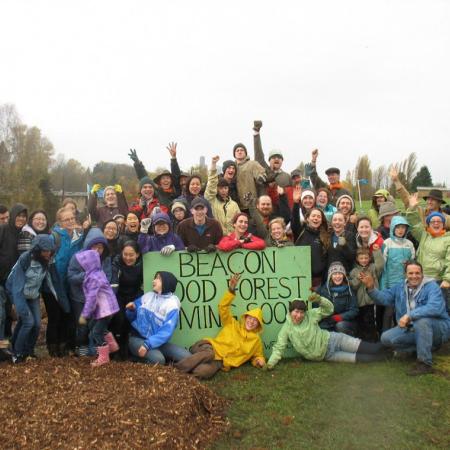
I first learned about the Beacon Food Forest as the first urban public food forest in the world. However, what truly inspires me is that how a group of people realized their vision from just a course project, which has now become an indispensable center of life for many in the community.
The idea of a public food forest was brought up by Mr. Glenn Herlihy and Ms. Jacqueline Cramer as a course project in 2009. After the course ended, the project continued to carry on with the support of Herlihy's and Cramer's family and friends. However, to carry out such a project was a strenuous process. It involved getting approval from the landowners (City government), getting wide support from the local community to show that the project was of common interest, getting a licensed landscape architect to draw a legitimate design map, and going through every legal process to acquire permit and resources necessary to alter the public landscape.
When the first tree was finally planted on site, it was already 2012. Over the 3 years, hundreds of people had worked together for a common goal. People of various backgrounds had donated labor, tools, skills and even a professional design map. While the amount of commitment and patience shown by the community is unbelievable, the willingness of Herlihy and Cramer to let go of their original design to make the project everyone's is even more inspiring.
I joined a work party at the Beacon Food Forest in March 2017, surprised by the 50 people showed up to get their hands dirty on a cold, rainy day. I was also surprised by the fact that most people come here not because they can grow healthy food for free, but because they feel at home with the people and plants here. Mr. Kenji Nakagawa, who used to live just down the street but had spent most of his years away, was one of those people. Nakagawa is now a member of the steering committee. I guess neither Herlihy or Cramer had seen this coming; that a project which started out to provide food and education turned out to be a healing environment for social solitude.
The idea of urban gardening is nothing new; however, the Beacon Food Forest is most different in that it is entirely open to anyone who wishes to participate, either in a long-term commitment to care for the land or in a one-time harvesting event. I guess this is why it is still prospering to this day.


